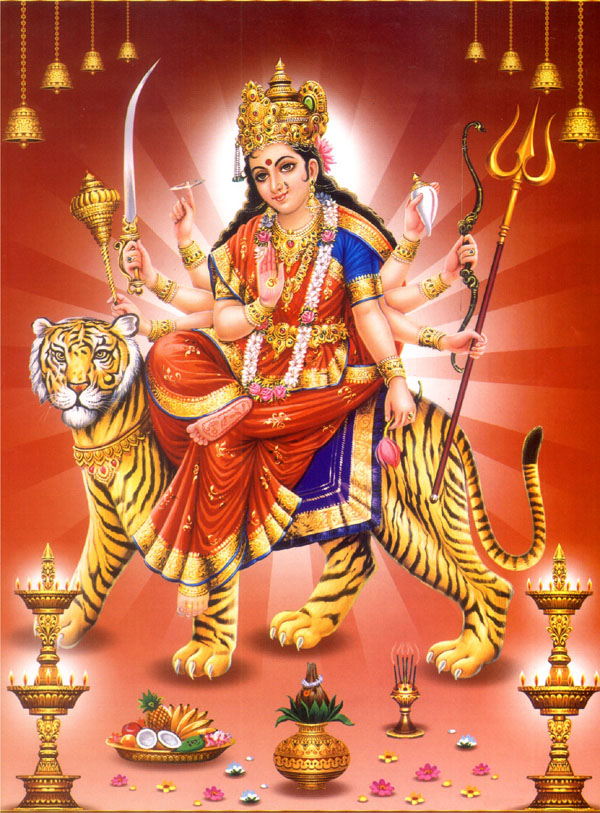The Significance Of Navaratri
One of the most important Hindu festivals of the year, Navaratri is celebrated in honor of Goddess Durga. While this is a pan India festival, it is not exactly celebrated in the same way throughout the country. In fact, each state has its own traditions, customs and rituals associated with Navaratri.

Goddess Durga
Navaratri literally means nine nights. While there are 4 seasonal Navaratris, the most important is the Sharada Navaratri celebrated in the month of Ashvin (September / October). Sharad means autumn in Indian languages. So Sharada Navaratri is the Navarathri celebrated in the autumn month of Ashwin. It is a 10 day festival (9 nights and 10 days). It is celebrated from the first day of the bright half in the month of Ashvin and concludes on the 10th day with much religious fervor and pomp.
Chaitra Navaratri
Navaratri is also celebrated in March/April and it is known as Chaitra Navaratri. Chaitra is the first month of the Indian calendar. Celebrations start from the first day (Pratipada) of the bright half (Sukla Paksha) in Chaitra and concludes on the 9th day (Navami). Chaitra Navaratri is mainly celebrated in Maharashtra, Karnataka and Andhra Pradesh. In Maharashtra, it begins with Gudi Padva, their New Year. In Karnataka and Andhra, it is celebrated as Ugadi.
Many variations of Navaratri
In North East India and West Bengal, Sharada Navaratri is celebrated in the form of Durga Puja. It typically lasts six days and concludes on Vijaya Dashami. Just like Navaratri celebrated in other parts of the country, Durga Puja also celebrates the victory of Goddess Durga over Mahishasur. Legend has it that her battle with Mahishasur started on Saptami (the 7th day of the Navaratri festival) and concluded with her slaying the demon on Dashami (the 10th day). Vijaya means victory. Hence, Vijaya Dashami is the day of victory – the day when goodness and virtue prevailed over vice.
See also
Navaratri celebrations in Kerala
Navaratri celebrations in Maharashtra
Best places to celebrate Navaratri in India
Kullu-Dussehra | Best Dussehra celebration in the country
Ras Garba and Dandiya | Navaratri celebrations in Gujarat
How is Navaratri celebrated?
While the way Navarathri is celebrated differs from state to state, there are still a central theme and common rituals. Throughout India, Navaratri celebrates the victory of virtue over vice. The nine forms of Goddess Durga are worshipped on these nine days/nights. While Durga is the most worshipped deity during Navaratri, it is also common for the festivities to involve the worshipping of Goddess Lakshmi, Saraswathi and Lord Ram.
Hindus celebrate the festival in many different ways. It is common for devotees to recite verses from Hindu scriptures during their daily puja. Fasting is an important aspect of the celebration in many states. Of course, it will be followed by feasting. It is also common to erect pandals (make shift temples) where an idol of the Goddess is installed and worshipped. There is usually a friendly competition between various Navarathri mandals erecting these pandals as each one wants their pandal and celebration to be the best. In southern states, especially in the state of Kerala, Goddess Saraswati is the focal point of Navaratri celebrations. Since Saraswati is the Goddess of learning and art, these nine days are considered particularly important and auspicious for students and those who engage in the practice of dance and singing. Nearly all Goddess temples in Kerala give artists (both famous and not-so-famous) to perform classical dance or recite music on their Navaratri mandapams during these days. It is an opportunity for local talent to showcase their skills as a tribute to the Goddess and earn her blessings.
On the 10th day, Vijaya Dashami, idols installed in various pandals are taken out in a procession and immersed in a water body.